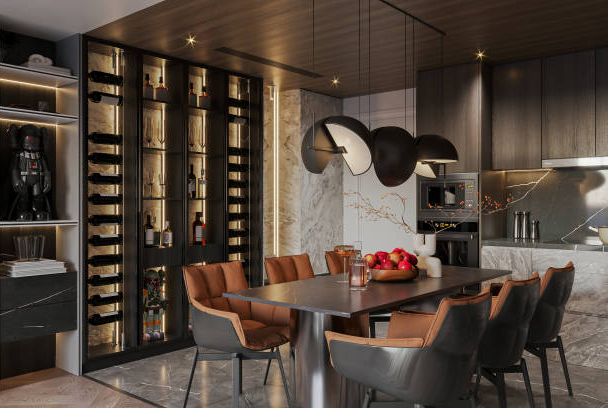Wine Cellar Design: From Storage to Showcase in Luxury Homes

Summary
- Wine cellars in luxury homes are no longer just for storing wine. They’re now stylish spaces that also serve as entertainment areas.
- Modern wine cellars combine beauty and function. They feature glass walls, custom racks, lighting, and climate control systems to display wine collections.
- They can be placed in basements or other rooms. They are designed with tasting areas, art displays, and comfortable seating.
- The design process requires careful planning. This includes location, storage space, climate control, and sometimes building permits.
- Hiring experienced experts is key. It helps achieve a wine cellar that enhances the beauty, value, and enjoyment of your home.
Table of Contents
Introduction
Are you looking for the perfect way to add class and value to your home? Modern wine cellar design ideas are redefining luxury living by turning into a statement of taste, craftsmanship, and lifestyle. In today’s homes, wine cellars are not designed just for storage, but as elegant showcases for your wine collections, blending functionality with aesthetic appeal.
In this article, House to Home experts delve into the essential considerations for creating the perfect environment for your prized vintages. We will also explore the various elements of a wine cellar design. If you’re looking for more than just storage, but also a way to impress your guests, elevate your home, and protect your vintages, then this blog is for you.
Rising Trend of Wine Cellars in Luxury Homes
Homeowners are increasingly prioritizing personal interests and lifestyle experiences when designing their homes. Home cinemas, wellness spas, bespoke interior features, and tastefully designed kitchens are reflections of individuality in luxury homes. And for wine lovers, wine cellars offer a perfect blend of their passion and prestige.
According to GMI Insights, the global wine cellar market is projected to reach a valuation of $5.2 billion in 2034. Changes in lifestyle and disposable income fuel this growth.
Collecting wine is shifting from a hobby to a status symbol and investment. Wine cellars in luxury homes are also not just about storage. They are functional, eye-catching, and adaptable, making them perfect for modern home designs.
For many homeowners, wine cellars double as an entertainment space, showcasing rare vintages and allowing guests to enjoy intimate tastings. This fusion of practicality and elegance is why wine cellars are increasingly viewed as a necessity for luxury homes and a long-term investment for home value.
Why Luxury Homes Need More Than Just Storage
In a luxury home, a wine cellar is more than just a storage space; it is valued for the experience it creates. A well-designed wine cellar can turn a simple room into the heart of your home’s entertainment. When you have a wine cellar, you’re offering a space rich in luxury, ambience, storytelling, and presentation.
Modern wine cellar design ideas blend form with functionality. Many rooms use sleek glass enclosures, custom racking, ambient lighting, and tactile materials to turn every bottle into a visual masterpiece.
They also incorporate seating areas, art displays, or even chef’s tables to create the perfect space for entertainment and quiet indulgence. Elevating your wine cellar from just a storage space into a showcase reflects your style, enhances your home’s aesthetics, and increases its value.
Planning Your Wine Cellar: Key Considerations
Planning a wine cellar involves careful consideration of the location, climate control, storage capacity, and local building regulations.
1. Location
The perfect location for your wine cellar balances accessibility with protection. Basements are often the ideal location due to their natural insulation and stable temperature. If a basement isn’t available, modern technology has made it possible to have your wine room above ground – either in a spare room, kitchen, below the stairs, or dining room.
Wherever you decide to place it, minimize exposure to light, temperature fluctuation, and vibrations.
2. Storage Capacity
Your wine cellar should not only reflect your current collections, but also have space to accommodate future additions. You should also optimize for bottle size, as larger bottles may require customized racks.
3. Climate Control and Insulation Needs
Maintain a consistent temperature, ideally around 55°F (13°C), and avoid significant temperature fluctuations. Also, ensure humidity levels between 50-70% to prevent corks from drying out and potentially spoiling the wine.
Proper insulation and a vapor barrier are also crucial for maintaining a stable temperature and humidity level.
4. Building Regulations (if any)
Planning your wine cellar requires significant structural modifications, which may require permits or adherence to building codes. For example, altering load-bearing walls or installing specialized electrical and ventilation systems are substantial changes that require special permission from local building authorities.
Additionally, homeowners’ association rules may influence modern home wine cellar designs. So, consult with your contractor to prevent delays.
Elements in Sophisticated Wine Cellar Design
If you are wondering how to turn a room into a wine cellar, these are the key elements that must be present in your modern wine cellar design ideas:
1. Custom Racking Systems
Sophisticated wine cellars often feature custom racking, which is tailored to bottle size, display angles, and overall room design. Consider using durable materials like wood or metal for organizing and displaying your collection. And glass enclosures for showcasing your prized bottles.
2. Climate Control
A consistent environment is crucial to maintaining and preserving the quality of your wines. Modern wine cellars often integrate built-in cooling systems to regulate temperature and smart monitoring systems to alert owners to temperature fluctuations.
3. Lighting
Use dimmable LED lights with warm tones to create a soft and inviting ambiance in your wine rooms. Custom lighting arrangements reflect stylish living and add to the aesthetics of your space. Popular lighting options include:
- Backlit racking for dramatic effect.
- Undershelf lighting to highlight labels.
- Soft accent lighting to enhance the room’s ambience.
4. Architectural Features
Design elements such as archways, vaulted ceilings, decorative tile work, etc, add character and visual interest to your wine cellar.
Enhancing the Space for Entertainment
In today’s luxury homes, wine cellars are far from the usual hidden spaces – they now double as an intimate venue for hosting guests. To enhance a wine cellar for entertainment, focus on creating a social atmosphere with features like comfortable seating, strategic lighting, and a tasting table.
1. Tasting Areas
A dedicated tasting table or bar-height counters invite guests for wine tasting and conversation. You can pair this with comfortable seating and soft lighting, balancing comfort with style.
2. Display Cases
For those who want the wine cellars to be the centerpiece of the room, display cases offer the perfect opportunity to showcase prized bottles or vintages.
3. Personalized Touches
Add elements like custom artwork, a wall-mounted wine opener, and elegant architectural designs to add character and style to the room.
4. Sensory Enhancements
Incorporate soft music, integrated sound systems, and discreet speakers to help set the mood and enhance the overall sensory experience.
Hiring the Right Experts for Your Wine Cellar Design
Building custom modern wine rooms is an investment that requires careful planning and execution. A wine cellar is not just a place to store your collections, but also a space for hosting guests and relaxing. Here are tips for choosing the right experts to implement your modern wine cellar design ideas:
- Check their portfolio: A good contractor will have a portfolio that showcases their expertise and experience. Prioritize builders that have years of experience in designing wine cellars of all styles and sizes.
- Ask for references: Request references and testimonials from past clients. Take time to speak to them about their experiences with the contractor and the quality of their work. Also, pay attention to recurring feedback as it would give you a clue to the contractor’s reliability.
- Communication: A good contractor should be able to explain key concepts and ideas clearly. They should be easy to reach and responsive to your requests, questions, and concerns.
- Ask about their process: When working with a builder, it is important to understand their process, the stages of implementation, and their quality control methods. Knowing their process helps you have clear expectations and gives you a clue to their expertise and reliability.
Read More: Reasons to Hire a Professional General Contractor
Conclusion
You’re not just preserving your prized vintages by embracing modern wine cellar design ideas. You’re also creating the perfect space for entertaining guests, enhancing the aesthetics of your home, and increasing its resale value.
However, building the perfect wine cellar requires more than just creating a space and racking the wines. An ideal location would be a basement or an above-ground space with custom lighting, temperature control features, and glass enclosures to showcase your collections.
Get a free consultation with House to Home experts on how to design a wine cellar.
FAQs
A modern wine cellar is a space in a home. It is designed to store wine under the right conditions. It also serves as a stylish showcase and entertainment area.
The best place to build a modern wine cellar is in the basement. This is because it has stable temperatures. Wine cellars can also be built in rooms above ground with proper technology.
A well-designed wine cellar should have a stable temperature (55°F/13°C; 50-70% humidity), smart cooling and monitoring systems, and high-quality insulation.
Wine cellars need a stable temperature because wine needs to stay fresh and avoid damage.
A luxury wine cellar costs between $60,000 and $100,000+. It includes high-end materials like exotic wood, stone, glass, smart climate control, and advanced security.
To build a proper wine cellar, you must choose the perfect location and ensure storage capacity. You must also ensure precise climate control and adherence to building regulations.
Yes, an elegantly designed wine cellar can enhance the value and aesthetic appeal of a luxury home.
A permit is not always needed. But in cases of major structural changes or electrical work, it requires a permit.
Custom racks, glass enclosures, soft LED lighting, tasting tables, artworks, and unique structural details.
Experienced contractors should build a wine cellar. Experts who have strong portfolios and understand climate, design, and construction needs.
About Author

Founder & Chief Sales Officer, House to Home
John Hayes is the Founder and Chief Sales Officer of House to Home Design Build Remodel, a leading general contracting firm serving homeowners across North County San Diego.
